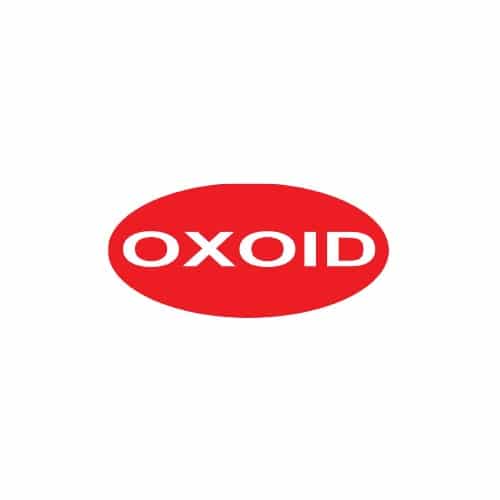
Defibrinated Horse Blood (25ML)
Login to see pricesBrand:
Thermo ScientificTM OxoidTM
Thermo Scientific™ Oxoid Defibrinated Horse Blood is a blood product.
**This product is not available at the moment.

Defibrinated Sheep Blood (25ML)
Login to see pricesBrand:
Thermo ScientificTM OxoidTM
Thermo Scientific™ Oxoid Defibrinated Sheep Blood is a blood product.
**This product is not available at the moment.

Dehydrated Rogosa Agar 500g
Login to see pricesBrand:
Thermo ScientificTM OxoidTM
Oxoid Rogosa Agar is used for the selective isolation and enumeration of lactobacilli.
Rogosa Agar, Oxoid Composition
| Typical Formula* | gm/litre |
| Tryptone | 10.0 |
| Yeast extract | 5.0 |
| Glucose | 20.0 |
| Sorbitan mono-oleate `Tween 80’ | 1.0ml |
| Potassium dihydrogen phosphate | 6.0 |
| Ammonium citrate | 2.0 |
| Sodium acetate, anhydrous | 17.0 |
| Magnesium sulphate | 0.575 |
| Manganese sulphate | 0.12 |
| Ferrous sulphate | 0.034 |
| Agar | 20.0 |
| pH 5.4 ± 0.2 @ 25°C |
Rogosa Agar, Oxoid Preparation:
Suspend 82g in 1 litre of distilled water and bring to the boil to dissolve completely. Add 1.32ml glacial acetic acid and mix thoroughly. Heat to 90-100°C for 2-3 minutes with frequent agitation. Distribute into sterile tubes, Petri dishes or bottles.
DO NOT AUTOCLAVE.
Storage conditions and Shelf life
Store the dehydrated medium at 10-30°C and use before the expiry date on the label.
Store the prepared medium at 2-8°C.
Precautions
Lactobacillus carnis does not grow on this medium.
All colonies must be tested by Gram stain and catalase test before carrying out further identification tests.

Dermasel Agar Base 500g
Login to see pricesBrand:
Thermo ScientificTM OxoidTM
- Oxoid Dermasel Agar Base is used for primary isolation and identification of dermatophyte fungi.
- Also available Dermasel Selective Supplement, Part No. SR0075E.
Dermasel Agar Base, Oxoid Composition
| Typical Formula* | gm/litre |
| Mycological peptone | 10.0 |
| Glucose | 20.0 |
| Agar | 14.5 |
| pH 6.9 ± 0.2 @ 25°C |
Dermasel Agar, Oxoid Preparation:
Suspend 44.5g in 1 litre of distilled water and heat gently to dissolve completely. Add the contents of 1 vial of Dermasel Selective Supplement SR0075, reconstituted as directed in the product insert, to each 500ml of medium to give a level of cycloheximide 0.4g/l and chloramphenicol 0.05g/l. Mix gently and sterilise by autoclaving at 121°C for 10 minutes. Avoid overheating at any time.
Storage conditions and Shelf life
Store the dehydrated medium at 10-30°C and use before the expiry date on the label.
Store the prepared agar plates at 2-8°C.
Precautions
This medium should not be used if agents causing systemic mycoses are being sought9. If such agents are suspected e.g. cryptococcus, histoplasma etc., either Dermasel Agar Base without antibiotic supplement must be used in parallel or Brain Heart Infusion Agar CM0375.
If the fungal agent sought is suspected to be nutritionally fastidious, the use of Brain Heart Infusion Agar is particularly helpful.
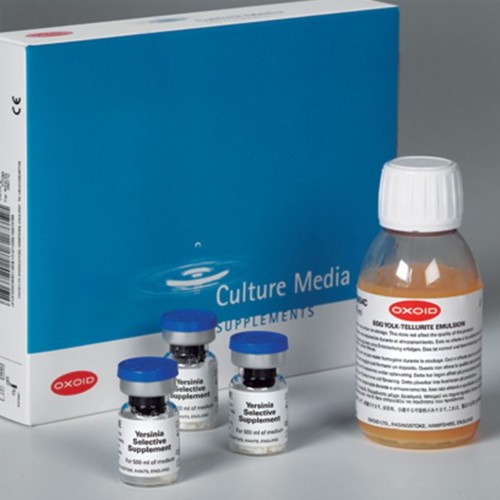
Dermasel Selective Supplement
Login to see pricesBrand:
Thermo ScientificTM OxoidTM
Oxoid Dermasel Selective Supplement is used for Dermasel Medium, Part No. CM0539B.
- Each vial supplements 500mL of medium
Dermasel Selective Supplement, Oxoid Composition
| Vial contents | per vial | per litre |
| Cycloheximide | 200mg | 400mg |
| Chloramphenicol | 25.0mg | 50.0mg |
Dermasel Agar, Oxoid Preparation:
Suspend 44.5g in 1 litre of distilled water and heat gently to dissolve completely. Add the contents of 1 vial of Dermasel Selective Supplement SR0075, reconstituted as directed in the product insert, to each 500ml of medium to give a level of cycloheximide 0.4g/l and chloramphenicol 0.05g/l. Mix gently and sterilise by autoclaving at 121°C for 10 minutes. Avoid overheating at any time.
Storage conditions and Shelf life
Store the dehydrated medium at 10-30°C and use before the expiry date on the label.
Store the prepared agar plates at 2-8°C.
Precautions
This medium should not be used if agents causing systemic mycoses are being sought9. If such agents are suspected e.g. cryptococcus, histoplasma etc., either Dermasel Agar Base without antibiotic supplement must be used in parallel or Brain Heart Infusion Agar CM0375.
If the fungal agent sought is suspected to be nutritionally fastidious, the use of Brain Heart Infusion Agar is particularly helpful.
Dermasel Selective Supplement SR0075 contains a toxic concentration of cycloheximide. Note the precautions to be taken under HAZARDS.

Desoxycholate Agar 500g
Login to see pricesBrand:
Thermo ScientificTM OxoidTM
Isolate, enumerate and differentiate coliforms in dairy products with differential Thermo Scientific™ Oxoid™ Desoxycholate Agar (Dehydrated). The medium is also used for the isolation of enteric pathogens from rectal swabs, feces or other specimens. Differentiation of coliforms is based on the fermentation of lactose. Lactose fermenting bacteria form pink colored colonies while non-lactose fermenters form straw colored colonies.
Desoxycholate Agar, Oxoid Composition
| Typical Formula* | gm/litre |
| Peptone | 10.0 |
| Lactose | 10.0 |
| Sodium desoxycholate | 1.0 |
| Sodium chloride | 5.0 |
| Dipotassium hydrogen phosphate | 2.0 |
| Ferric citrate | 1.0 |
| Sodium citrate | 1.0 |
| Neutral red | 0.03 |
| Agar | 15.0 |
| pH 7.1 ± 0.2 @ 25°C |
Desoxycholate Agar, Oxoid Preparation:
Suspend 45g in 1 litre of distilled water. Bring to the boil over gauze and flame to dissolve the medium completely. Agitate to prevent charring.
THIS MEDIUM IS HEAT SENSITIVE. AVOID EXCESSIVE OR PROLONGED HEATING DURING RECONSTITUTION. DO NOT AUTOCLAVE OR REMELT.
Storage conditions and Shelf life
Store the dehydrated medium at 10-30°C and use before the expiry date on the label.
Store the prepared agar plates at 2-8°C.

Desoxycholate Citrate Agar (Hynes) 500g, Oxoid
Login to see pricesBrand:
Thermo ScientificTM OxoidTM
An improved medium, based on the Hynes modification of Leifsons medium for the isolation of Salmonellae and Shigellae. The improvement gives larger and more numerous colonies of Shigella species which can easily be picked off and emulsified in saline for slide agglutination tests.
Desoxycholate Citrate Agar (Hynes), Oxoid Composition
| Typical Formula* | gm/litre |
| `Lab-Lemco’ Powder | 5.0 |
| Peptone | 5.0 |
| Lactose | 10.0 |
| Sodium citrate | 8.5 |
| Sodium thiosulphate | 5.4 |
| Ferric ammonium citrate | 1.0 |
| Sodium desoxycholate | 5.0 |
| Neutral red | 0.02 |
| Agar | 12.0 |
| pH 7.3 ± 0.2 @ 25°C |
Desoxycholate Citrate Agar (Hynes), Oxoid Preparation:
Suspend 52g in 1 litre of distilled water. Bring to the boil over gauze and flame, to dissolve completely. Agitate to prevent charring. Cool to approximately 50°C and pour into sterile Petri dishes. Dry the agar surface before use.
THIS MEDIUM IS HEAT SENSITIVE: AVOID EXCESSIVE OR PROLONGED HEATING DURING RECONSTITUTION. DO NOT AUTOCLAVE OR REMELT.
Storage conditions and Shelf life
Store the dehydrated medium at 10-30°C and use before the expiry date on the label.
Store the prepared agar plates at 2-8°C.
Precautions
The medium is best used freshly prepared.
Stock cultures of Shigella species may become predominantly in the R-phase when subcultured away from DCA media. Such cultures are difficult to use for control purposes without first heavily streaking the cultures on DCA plates and picking off the few S-phase colonies i.e. the macro-colonies on the agar surface, for further subculture.
When making biochemical tests on colonies picked from the surface of DCA plates, purity subcultures should be carried out because the colony may be contaminated with Escherichia coli present as micro-colonies.

Desoxycholate Citrate Agar 500g
Login to see pricesBrand:
Thermo ScientificTM OxoidTM
Oxoid Desoxycholate Citrate Agar is a differential medium for enumeration of coliforms and the isolation of enteric pathogens.
Desoxycholate Citrate Agar, Oxoid Composition
| Typical Formula* | gm/litre |
| Lab-Lemco’ powder | 5.0 |
| Peptone | 5.0 |
| Lactose | 10.0 |
| Sodium citrate | 5.0 |
| Sodium thiosulphate | 5.0 |
| Ferric citrate | 1.0 |
| Sodium desoxycholate | 2.5 |
| Neutral red | 0.025 |
| Agar | 15.0 |
| pH 7.0 ± 0.2 |
Desoxycholate Citrate Agar, Oxoid Preparation:
Suspend 48.5g in 1 litre of distilled water. With frequent agitation bring to the boil over a gauze and flame to dissolve completely. Mix well and pour plates immediately. Dry the agar surface before use.
THIS MEDIUM IS HEAT SENSITIVE. AVOID EXCESSIVE OR PROLONGED HEATING DURING RECONSTITUTION. DO NOT AUTOCLAVE, OR REMELT.
Storage conditions and Shelf life
Store the dehydrated medium at 10-30°C and use before the expiry date on the label.
Store the prepared agar plates at 2-8°C.
Precautions
The medium is best used freshly prepared.
Stock cultures of Shigella species may become predominantly in the R-phase when subcultured away from DCA media. Such cultures are difficult to use for control purposes without first heavily streaking the cultures on DCA plates and picking off the few S-phase colonies i.e. the macro-colonies on the agar surface, for further subculture.
When making biochemical tests on colonies picked from the surface of DCA plates, purity subcultures should be carried out because the colony may be contaminated with Escherichia coli present as micro-colonies.
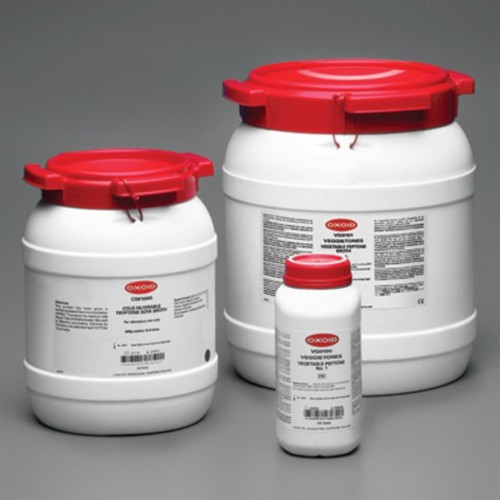
Dextrose Bacteriological 500g
Login to see pricesBrand:
Thermo ScientificTM OxoidTM
Oxoid Dextrose Bacteriological is a sugar suitable for inclusion in bacteriological culture media.

Dextrose Tryptone Agar 500g
Login to see pricesBrand:
Thermo ScientificTM OxoidTM
Oxoid Dextrose Tryptone Agar is used for detection and enumeration of thermophilic and mesophilic microorganisms in food.
Dextrose Tryptone Agar, Oxoid Composition
| Typical Formula* | gm/litre |
| Tryptone | 10.0 |
| Dextrose | 5.0 |
| Bromocresol purple 1 | 0.04 |
| Agar | 12.0 |
| pH 6.9 ± 0.2 |
Dextrose Tryptone Agar, Oxoid Preparation:
Suspend 27g in 1 litre of distilled water and bring to the boil to dissolve completely. Sterilise by autoclaving at 121°C for 15 minutes.
Storage conditions and Shelf life
Store the dehydrated medium at 10-30°C and use before the expiry date on the label.
Store the prepared agar plates at 2-8°C.
Precautions
Incubation at 55°C must be carried out under humid conditions e.g. wrapped dishes or in a high humidity environment.

Dextrose Tryptone Broth 500g
Login to see pricesBrand:
Thermo ScientificTM OxoidTM
Oxoid Dextrose Tryptone Broth is used for detection and enumeration of thermophilic and mesophilic microorganisms in food.
Dextrose Tryptone Broth, Oxoid Composition
| Typical Formula* | gm/litre |
| Tryptone | 10.0 |
| Dextrose | 5.0 |
| Bromocresol purple | 0.04 |
| pH 6.9 ± 0.2 |
Dextrose Tryptone Broth, Oxoid Preparation:
Add 15g to 1 litre of distilled water. Mix well and distribute into final containers. Sterilise by autoclaving at 121°C for 15 minutes.
Storage conditions and Shelf life
Store the dehydrated medium at 10-30°C and use before the expiry date on the label.
Store the prepared broth below 25°C.

DG 18 (Dichloran Glycerol Chloramphenicol) Agar (Base), Merck
Login to see pricesBrand:
Merck
Description
This DG 18 (Dichloran glycerol chloramphenicol) agar (base) is tested according to ISO 21527 and FDA-BAM GranuCult®. DG 18 Agar is suitable to enumerate and isolate xenophilic moulds from dried and semi-dried foods such as dried fruits, spices, confectionery, cereals, nuts, and dried meat and fish products.

Diagnostic Sensitivity Test Agar 500g
Login to see pricesBrand:
Thermo ScientificTM OxoidTM
Diagnostic Sensitivity Test Agar was developed in Oxoid as a dual purpose medium which would satisfy both diagnostic and susceptibility requirements.
Diagnostic Sensitivity Test Agar, Oxoid Composition
| Typical Formula* | gm/litre |
| Proteose peptone | 10.0 |
| Veal infusion solids | 10.0 |
| Glucose | 2.0 |
| Sodium chloride | 3.0 |
| Disodium phosphate | 2.0 |
| Sodium acetate | 1.0 |
| Adenine sulphate | 0.01 |
| Guanine hydrochloride | 0.01 |
| Uracil | 0.01 |
| Xanthine | 0.01 |
| Aneurine | 0.00002 |
| Agar | 12.0 |
| pH 7.4 + 0.2 @ 25°C |
Diagnostic Sensitivity Test Agar, Oxoid Preparation:
Add 40 g to 1 litre of distilled water. Bring to the boil to dissolve completely. Sterilise by autoclaving at 121°C for 15 minutes.
For blood agar, cool the base to 50°C and add 7% of Defibrinated Horse Blood SR0050. Mix with gentle rotation and pour into Petri dishes (12 ml for a 9 cm dish) or other containers.
RECONSTITUTION AND MIXING SHOULD BE PERFORMED IN A FLASK AT LEAST 2.5 TIMES THE VOLUME OF MEDIUM TO ENSURE ADEQUATE AERATION OF THE BLOOD.
Storage conditions and Shelf life
Store the dehydrated medium at 10-30°C and use before the expiry date on the label.
Store the prepared agar plates at 2-8°C.
Precautions
Diagnostic Sensitivity Test Agar has reduced thymidine activity and this will affect its performance as a primary isolation medium.

Dichloran-Glycerol (DG18) 500g
Login to see pricesBrand:
Thermo ScientificTM OxoidTM
- Oxoid Dichloran-Glycerol (DG18) Agar Base is a selective low water activity (aw) medium for xerophilic molds from dried and semi-dried foods.
- Also available Chloramphenicol Selective Supplement, Part No. SR0078E and Chloramphenicol Selective Supplement, Part No. SR0078H.
Dichloran-Glycerol (DG18) Agar Base, Oxoid Composition
| Typical Formula* | gm/litre |
| Peptone | 5.0 |
| Glucose | 10.0 |
| Potassium dihydrogen phosphate | 1.0 |
| Magnesium sulphate | 0.5 |
| Dichloran | 0.002 |
| Agar | 15.0 |
| Final pH 5.6 ± 0.2 @ 25°C |
Dichloran-Glycerol (DG18) Agar, Oxoid Preparation:
Suspend 15.75g in 500ml (31.5g/l) of distilled water and heat to dissolve completely. Add 110g per 500ml (220g/l) of Glycerol (Analytical Reagent grade). Reconstitute one vial SR0078E per 500ml medium or one vial SR0078H per 2 litres medium, as directed. Add the vial contents to the DG18 Agar Base. Sterilise by autoclaving at 121°C for 15 minutes. Cool to 50°C, mix well and pour into sterile Petri dishes.
Storage conditions and Shelf life
Store the dehydrated medium at 10-30°C and use before the expiry date on the label.
Store the prepared plates at 2-8°C.
Precautions
The dichloran compound used in this medium is Botran® 2,6-Dichloro-4-Nitro-Analine (CAS: 99-30-9).

DNase agar 500g
Login to see pricesBrand:
Thermo ScientificTM OxoidTM
Detect microbial deoxyribonuclease enzymes, particularly from staphylococci, with Thermo Scientific™ Oxoid™ DNASE Agar (Dehydrated). A DNase (deoxyribonuclease) is any enzyme that catalyzes the cleavage of phosphodiester linkages of DNA leading to its degradation. The organisms producing DNase enzymes in sufficient quantities to hydrolyze DNA will show clear zones around the colonies. The medium is mainly used in the identification of staphylococci but may also be used for the detection of DNase activity in other organisms.
DNASE Agar, Oxoid Composition
| Typical Formula* | gm/litre |
| Tryptose | 20.0 |
| Deoxyribonucleic acid | 2.0 |
| Sodium chloride | 5.0 |
| Agar | 12.0 |
| pH 7.3 + 0.2 |
DNASE Agar, Oxoid Preparation:
Suspend 39g in 1 litre of distilled water and bring to the boil to dissolve completely. Sterilise by autoclaving at 121°C for 15 minutes.
Storage conditions and Shelf life
Store the dehydrated medium at 10-30°C and use before the expiry date on the label.
Store the prepared plates of medium at 2-8°C.
Precautions
The DNase reaction for staphylococci is an indication of pathogenicity, it cannot be used as the sole criterion for identification.
Small zones of clearing may be caused by other enzymes or organic acid production.
Other organisms than staphylococci, Serratia and aeromonads can produce DNases.
Once the hydrochloric acid has been applied to the medium the plate must be read within a few minutes and further testing cannot be carried out by re-incubation.
The methyl green must be purified by extraction with chloroform.
Toluidine blue varies in performance according to source.
Merck Toluidine blue 1273 is satisfactory. Note that this dye cannot be used for Gram positive organisms.
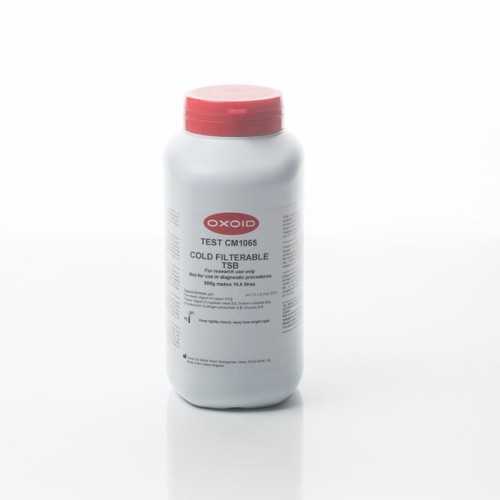
DRBC (ISO) Agar Base 500g
Login to see pricesBrand:
Thermo ScientificTM OxoidTM
Isolate and enumerate yeasts and molds associated with food spoilage with Thermo Scientific™ Oxoid™ Dichloran Rose-Bengal Chloramphenicol (DRBC) (ISO) Agar Base while adhering to ISO 21527-1: 2008. Dichloran Rose-Bengal Chloramphenicol (DRBC) (ISO) Agar is specially designed to suppress the growth of spreading mold and bacteria while supporting the growth of species that cannot be isolated on Rose Bengal Chloramphenicol Agar or Acidified Potato Dextrose Agar.
Dichloran Rose-Bengal Chloramphenicol (DRBC) (ISO) Agar, Oxoid Composition
| Typical Formula* | gm/litre |
| Peptone | 5.0 |
| Glucose | 10.0 |
| Potassium dihydrogen phosphate | 1.0 |
| Magnesium sulphate | 0.5 |
| Dichloran | 0.002 |
| Rose-bengal | 0.025 |
| Agar | 15.0 |
| pH 5.6 ± 0.2 @ 25°C |
Dichloran Rose-Bengal Chloramphenicol (DRBC) (ISO) Agar, Oxoid Preparation:
Suspend 15.75g per 500ml (31.5g/l) of distilled water and heat to dissolve completely. Reconstitute Chloramphenicol Supplement (one vial SR0078E per 500ml or one vial SR0078H per 2 litres medium), as directed. Add the vial contents to the DRBC (ISO) Agar Base. Sterilize by autoclaving at 121°C for 15 minutes. Cool to 50°C, mix well and pour into sterile Petri dishes.
Storage conditions and Shelf life
Store the dehydrated medium at 10–30°C and use before the expiry date.
Precautions
ROSE-BENGAL PHOTO-OXIDIZES TO FORM TOXIC COMPOUNDS. STORE PLATES OF THE MEDIUM IN THE DARK AND AVOID EXPOSURE TO LIGHT.
Some strains of fungi may be inhibited on this medium.
The dichloran compound used in this medium is Botran® 2,6-Dichloro-4-Nitro-Analine (CAS: 99-30-9).
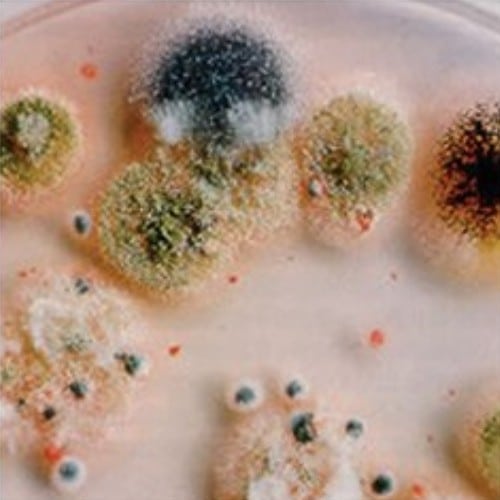
DRBC Agar Base 500g
Login to see pricesBrand:
Thermo ScientificTM OxoidTM
- Oxoid DRBC Agar Base (Dichloran Rose-Bengal Chloramphenicol Agar Base) is a selective medium for yeast and molds associated with food spoilage.
- Also available Chloramphenicol Selective Supplement, Part No. SR0078E and Chloramphenicol Selective Supplement, Part No. SR0078H
DRBC Agar Base, Oxoid Composition
| Typical Formula* | gm/litre |
| Peptone | 5.0 |
| Glucose | 10.0 |
| Potassium dihydrogen phosphate | 1.0 |
| Magnesium sulphate | 0.5 |
| Dichloran | 0.002 |
| Rose-Bengal | 0.025 |
| Agar | 15.0 |
| pH 5.6 ± 0.2 @ 25°C |
DRBC Agar, Oxoid Preparation:
Suspend 15.75g in 500ml (31.5g/l) of distilled water and heat to dissolve completely. Reconstitute one vial SR0078E per 500ml medium or one vial SR0078H per 2 litres medium, as directed. Add the vial contents to the DRBC Agar Base. Sterilise by autoclaving at 121°C for 15 minutes. Cool to 50°C, mix well and pour into sterile Petri dishes.
Storage conditions and Shelf life
Store the dehydrated medium at 10-30°C and use before the expiry date on the label.
Store the prepared plates of medium at 2-8°C.
Precautions
ROSE-BENGAL PHOTO-OXIDIZES TO FORM TOXIC COMPOUNDS. STORE PLATES OF THE MEDIUM IN THE DARK AND AVOID EXPOSURE TO LIGHT.
Some strains of fungi may be inhibited on this medium.
The dichloran compound used in this medium is Botran® 2,6-Dichloro-4-Nitro-Analine (CAS: 99-30-9).

E.C. Broth 500g
Login to see pricesBrand:
Thermo ScientificTM OxoidTM
Selectively detect Escherichia coli from food and environmental samples with Thermo Scientific™ Oxoid™ EC Broth (Dehydrated). EC Broth is a selective medium for the differentiation of fecal coliforms and the confirmatory test for Escherichia coli from food and environmental samples. It is also suitable for the enumeration of presumptive E. coli in milk and milk products using the most probable number technique.
EC Broth, Oxoid Composition
| Typical Formula* | gm/litre |
| Tryptone | 20 |
| Lactose | 5.0 |
| Bile salts No. 3 | 1.5 |
| Di-potassium phosphate | 4.0 |
| Mono-potassium phosphate | 1.5 |
| Sodium chloride | 5.0 |
| pH 6.9 ± 0.2 @ 25°C |
EC Broth, Oxoid Preparation:
Dissolve 37g in 1 litre of distilled water. Dispense into final containers and sterilize by autoclaving at 121°C for 15 minutes.
Storage conditions and Shelf life
Store the dehydrated medium at 10-30°C and use before the expiry date on the label.
Store the prepared medium at 2-8°C for up to 4 weeks.

E.C. Broth with Mug 500g
Login to see pricesBrand:
Thermo ScientificTM OxoidTM
Oxoid EC Broth with MUG is used for the isolation and presumptive identification of E. coli.
EC Broth with MUG, Oxoid Composition
| Typical Formula* | gm/litre |
| Tryptone | 20.0 |
| Lactose | 5.0 |
| Bile salts No. 3 | 1.5 |
| Di-potassium phosphate | 4.0 |
| Mono-potassium phosphate | 1.5 |
| Sodium chloride | 5.0 |
| 4-methylumbelliferyl-ß-D-glucuronide (MUG) | 0.05 |
| pH 6.9 ± 0.2 @ 25°C |
EC Broth with MUG, Oxoid Preparation:
Suspend 37g of EC Broth with MUG in 1 litre of distilled water. Mix well to dissolve and distribute into final containers containing inverted Durham tubes. Sterilise by autoclaving at 121° C for 15 minutes.
Storage conditions and Shelf life
Store the dehydrated medium at 10-30°C and use before the expiry date on the label.
Store the prepared medium at 2-8°C.
Precautions
Ensure that the glass tubes used for the preparation of the medium do not auto fluoresce and take the relevant safety precautions when using a UV lamp.
Some pathogenic strains, typically Escherichia coli O157:H7 are usually glucuronidase negative and therefore will not give a positive result in this test.
Other enteric organisms e.g. some Shigella species are also glucuronidase positive.

E.E. Broth 500g
Login to see pricesBrand:
Thermo ScientificTM OxoidTM
Enrich Enterobacteriaceae in bacteriological examination of foods and animal feed stuffs with Thermo Scientific™ Oxoid™ EE Broth (Buffered Glucose Brilliant Green Bile Broth) (Dehydrated). This medium is more inhibitory to non-Enterobacteriaceae than other non-selective media e.g. Mannitol broth or Lactose broth by virtue of the presence of brilliant green and bile salts in the preparation.
EE Broth, Oxoid Composition
| Typical Formula* | gm/litre |
| Peptone | 10.0 |
| Glucose | 5.0 |
| Disodium hydrogen phosphate anhyd. | 6.45 |
| Potassium dihydrogen phosphate | 2.0 |
| Ox Bile purified | 20.0 |
| Brilliant green | 0.0135 |
| pH 7.2 ± 0.2 @ 25°C |
EE Broth, Oxoid Preparation:
Add 43.5g to 1 litre of distilled water. Distribute 100ml quantities in 250ml flasks and heat at 100°C for 30 minutes only. Cool rapidly in cold running water. This medium is heat sensitive. DO NOT AUTOCLAVE.
Storage conditions and Shelf life
Store the dehydrated medium at 10-30°C and use before the expiry date on the label.
Store the prepared medium at 2-8°C.
Precautions
Avoid overheating the medium, especially the double-strength broth.
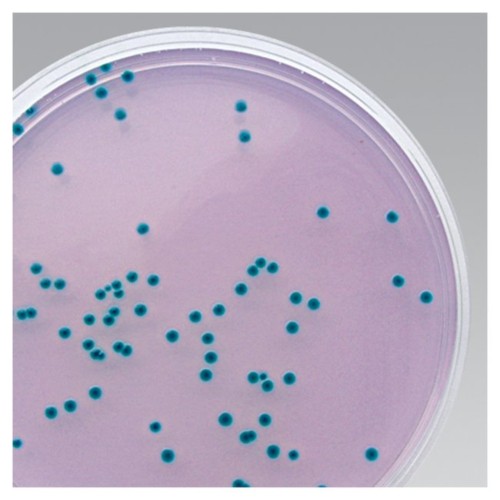
E.Sak Isolation Agar Base 500g
Login to see pricesBrand:
Thermo ScientificTM OxoidTM
Oxoid Cronobacter Sakazakii Isolation Agar (ISO) is a chromogenic medium for enrichment and isolation of Cronobacter spp. from milk and milk products in compliance with ISO/TS 22964: 2006.
E.Sak Isolation Agar Base, Oxoid Composition
| Typical Formula* | gm/litre |
| Pancreatic digest of casein† | 7.0 |
| Yeast extract | 3.0 |
| Sodium chloride | 5.0 |
| Sodium deoxycholate†† | 0.6 |
| 5-Bromo-4-chloro-3-indolyl α-D-glucopyranoside | 0.15 |
| Crystal violet | 0.002 |
| Agar | 12.0 |
| pH 7.0 ± 0.2 @ 25°C |
E.Sak Isolation Agar, Oxoid Preparation:
Suspend 27.75g in 1 litre of distilled water. Bring to the boil to dissolve completely. Sterilize by autoclaving at 121°C for 15 minutes. Cool to approximately 50°C. Mix well and pour into sterile Petri dishes.
Storage conditions and Shelf life
Store the dehydrated medium at 10-30°C and use before the expiry date on the label.
The prepared medium is best used freshly prepared, but may be suitable for longer storage following in-house validation.

EC Broth (Reduced Bile Salts) 500g
Login to see pricesBrand:
Thermo ScientificTM OxoidTM
- Oxoid EC Broth, Reduced Bile Salts is a selective enrichment broth for the growth of Escherichia coli O157 from food and environmental samples.
- Also available Novobiocin Selective Supplement, Part No. SR0181E.
EC Broth (Reduced Bile Salts), Oxoid Composition
| Typical Formula* | gm/litre |
| Tryptone | 20.0 |
| Lactose | 5.0 |
| Bile Salts No. 3 | 1.12 |
| Di-potassium phosphate | 4.0 |
| Mono-potassium phosphate | 1.5 |
| Sodium chloride | 5.0 |
| pH 6.9 ± 0.2 @ 25°C |
EC Broth (Reduced Bile Salts), Oxoid Preparation:
Dissolve 18.3g in 500ml of distilled water. Sterilise by autoclaving at 121°C for 15 minutes. Cool the EC Broth (Reduced Bile Salts) to 50°C and aseptically add the contents of 1 vial of Novobiocin Supplement SR0181, reconsituted as directed. Dispense into final sterile containers.
Storage conditions and Shelf life
Store the dehydrated medium at 10-30°C and use before the expiry date on the label.
When stored as directed, the supplement remains stable until the expiry date printed on the label.

Edwards Medium (Modified) 500g, Oxoid
Login to see pricesBrand:
Thermo ScientificTM OxoidTM
Oxoid Edwards Medium, Modified is used for selective isolation of Streptococcus agalactiae.
Edwards Medium, Modified, Oxoid Composition
| Typical Formula* | gm/litre |
| `Lab-Lemco’ powder | 10.0 |
| Peptone | 10.0 |
| Aesculin | 1.0 |
| Sodium chloride | 5.0 |
| Crystal violet | 0.0013 |
| Thallous sulphate | 0.33 |
| Agar | 15.0 |
| pH 7.4 ± 0.2 |
Edwards Medium, Modified, Oxoid Preparation:
Suspend 41g in 1 litre of distilled water. Bring to the boil to dissolve completely. Sterilise by autoclaving at 115°C for 20 minutes. Cool to 50°C, add 5-7% of sterile bovine or sheep blood, mix well and pour plates.
Storage conditions and Shelf life
Store the dehydrated medium at 10-30°C. and use before the expiry date on the label.
Store the prepared plates at 2-8°C.

Egg Yolk Tellurite Emulsion
Login to see pricesBrand:
Thermo ScientificTM OxoidTM
Thermo Scientific™ Oxoid Egg Yolk Tellurite Emulsion is an emulsion of egg yolk containing potassium tellurite for use in Baird-Parker Medium CM0275 and Baird-Parker Medium (ISO) CM1127.

